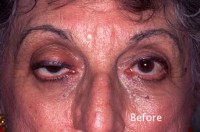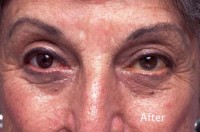Cancer Reconstruction
CANCER AND POST-CANCER RECONSTRUCTION
As with any exposed area of the body, skin cancer can affect the eyelids. Although all areas of the eyelids can be affected, skin cancer most commonly impacts the lower eyelids. Cancerous lesions typically present as a slowly growing mass, with ancillary symptoms such as the breaking down of the skin with rawness, crusting, and bleeding around the affected area.
There are various types of cancer that can impact, and potentially damage the delicate eyelid structures:

- Basal Cell Carcinoma: the most common of the skin cancers that affect the eyelids, basal cell carcinoma tends to have a heaped and pearly edge with central ulceration
- Squamous Cell Carcinoma: can present as a rough red patch of skin that slowly expands
- Sebaceous Cell Carcinoma: this form of cancerous lesion can grow insidiously along the eyelid, at times mistaken by even experienced doctors with chronic inflammation of the eyelid margin
- Melanoma: often pigmented, melanomas grow irregularly and may demonstrate a range of color, or even be without pigment
In addition to localized harm, several of these skin cancers (squamous cell carcinoma, melanoma, and sebaceous cell carcinoma) have the potential to spread to other parts of the body and can be life threatening. Basal cell carcinoma is unlikely to spread to other parts of the body, but causes localized damage if it is not surgically excised.
CANCER RECONSTRUCTION EXPERTISE
In order to ensure a safe and effective eyelid cancer surgery, it is crucially important to select an experienced oculofacial surgeon who possesses the necessary surgical skillset and in-depth knowledge of the intricate eye structures. You will find such a physician in Dr. Kenneth Steinsapir, a multi-fellowship-trained oculofacial plastic surgeon whose private practice is located in beautiful Beverly Hills, CA, where he specializes in personalized reconstructive eyelid surgery procedures and has a proven track record of producing successful reconstructive eyelid cancer surgery outcomes.
Treatment of eyelid skin cancers begins with a formal diagnosis established by sampling the lesion. This is done as a biopsy performed by your dermatologist, general ophthalmologist, or by Dr. Steinsapir, and can be comfortably performed with a little local anesthesia and the removal of a small punch of tissue. Generally the biopsy site, which is quite small, is left to heal on its own. If the biopsy does prove that the lesion is a skin cancer, the next steps for managing the lesion very much depend on the type of skin cancer. In virtually all cases, surgical excision is indicated to cure the cancer or maintain local control if there is evidence that the lesion has spread. Early diagnosis and treatment greatly increases the likelihood of a cure.
EYELID SKIN CANCER TREATMENT OPTIONS
The key with managing eyelid cancers is complete surgical excision. The cancer removal must be the primary concern of both doctor and patient, even over the aesthetic and functional consequences of removing the skin cancer. The specific technique employed for the cancer excision has a significant impact on both the successful treatment of the skin cancer and the preservation of the eyelid aesthetics and functionality. Traditionally, eyelid skin cancers were removed by the reconstructing eye plastic surgeon. After the removal, a pathologist would examine the edges of the excised tissue using frozen sections—this method is still used today and has a relatively high rate of success.
However, there is a more optimal method of excising eyelid skin cancers. This advanced technique involves a team approach where a dermatologist surgeon trained in Mohs’ cancer surgery excises the tumor and the eyelids are reconstructed by Dr. Steinsapir. There are two key advantages to this approach:
- The overall rate of success in excising the cancer is much higher than with the frozen section control technique. In some published series, successful outcomes achieved with this method approaches a 99% cure rate. This remarkably high success rate is due to the fact that this technique enables the Mohs’ surgeon to map and sample 100% of the surgical margin.
- This method is very economical in terms of preserving normal tissue surrounding the excision site, which produces a better aesthetic and functional result without compromising the skin cancer removal, thereby facilitating the healing process and shortening the post-surgical recovery period.
Once the Mohs’ surgeon has completed removal of the lesions, a dressing is placed over the area and Dr. Steinsapir examines the area. The wound closure may be performed in the office (if the defect is small) or on an outpatient basis at UCLA that day or the next day, depending upon the unique circumstances of each patient’s case. A personal consultation with Dr. Steinsapir will help to determine which surgical approach is appropriate for your treatment needs.
POST-CANCER SURGERY RECONSTRUCTION
It is the responsibility of the primary surgeon performing the eyelid cancer reconstruction to perform optimal closure of the treatment area after the skin cancer has been successfully removed. However, for a number of reasons, this initial closure often represents the best compromise at the time, making multiple-stage reconstruction necessary to achieve the best possible aesthetic and functional results.
In Dr. Steinsapir’s extensive experience, he has found that for a variety of reasons, patients do not always get the best advice regarding the value or functional purposes of having further eyelid reconstruction after cancer surgery. In some cases, the reconstructive surgeon has made their best effort and truly does not have the skillset to improve the functionality or aesthetics of the compromised area. In other cases, patients unfortunately receive the message that they are being vain or ungrateful in asking for a better reconstructive result.
Dr. Steinsapir prides himself on providing innovative approaches to improving the cosmetic appearance and proper functioning of eyelids that have been compromised by prior reconstructive surgery. In many cases, Dr. Steinsapir is able to produce results that show marked aesthetic improvements, helping patients to feel more confident and comfortable with their facial appearance. During your initial consultation, Dr. Steinsapir will discuss your options for safely and effectively improve the appearance and functioning of your eyelids after cancer surgery.
Eyelid Cancer Reconstruction Beverly Hills & Los Angeles
Dr. Steinsapir is a UCLA- and University of Chicago-trained surgeon who has performed separate fellowships in both Cosmetic Surgery and Oculofacial Microsurgery. He is board certified in Ophthalmology. Many individuals travel nationally and internationally to undergo cancer and/or post-cancer reconstructive eyelid surgery with Dr. Steinsapir. To learn how reconstructive eyelid surgery can address your eyelid skin cancer or enhance the appearance of your eyelids after eyelid cancer surgery, please contact our office.
You may also continue to explore Dr. Steinsapir’s website (www.Lidlift.com), where you will find supplementary information pertaining to cancer and post-cancer surgery and other reconstructive eyelid procedures, before-and-after reconstructive eyelid surgery case studies, and answers to frequently asked questions about these procedures. Your cancer/post-cancer reconstructive eyelid surgery can serve as a key stepping stone along the path to become the best possible version of yourself, and you can take the first step by calling to schedule your personal consultation with Dr. Steinsapir today.


